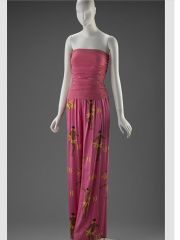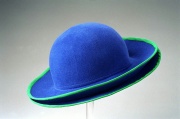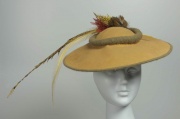Angora
Description
The long, fine hair from an Angora rabbit. The silky hair from an Angora goat is sometimes called angora but more often called Mohair. The Angora rabbit is native to Asia Minor, domesticated by the Trelicians since the 6th century, and only bred in Europe since the early 19th century. The white French rabbit produces high-quality, soft hair. The fur is trimmed every three months to produce clippings that are 3 inches long. Angora dyes readily, but is difficult to spin because of its fine texture. It is usually mixed with wool or other fibers for weaving cardigans and gloves. Angora easily felts and sometimes felts on the rabbit itself if not regularly groomed.
Synonyms and Related Terms
angorakanin (Sven.); angora (Esp. Fr., Ned.)
Risks
Deteriorated by alkalis
Susceptible to mold, mildew and static electricity
Physical and Chemical Properties
Guard hairs are a dumbbell shape; diagonal scales with serrated edges
Fine hairs are oval; flattened scales with wavy edges
Angora rabbits are domesticated and therefore do not fall under IUCN RED List considerations. For the same reasons (of domestication), their wool and woolen products are not regulated under CITES. National trade regulations may still be in effect.
Comparisons
Additional Images
Physical and Chemical Properties
- International Year of Natural Fibers 2009, Food and Agriculture Organization of the United Nations, at http://www.fao.org/natural-fibres-2009/about/15-natural-fibres/en/ (accessed April 6, 2020)
- Wikipedia at http://en.wikipedia.org/wiki/Angora_rabbit (Accessed April 6, 2020)
- Wikipedia at http://en.wikipedia.org/wiki/Angora_wool (Accessed April 6, 2020)
- CITES, Convention on International Trade in Endangered Species of Wild Flora and Fauna, at https://www.cites.org/ Comment: https://www.cites.org/eng/disc/species.php (accessed April 6, 2020)
- IUCN Red List, at https://www.iucnredlist.org/ (accessed April 6, 2020)
- Hoechst Celanese Corporation, Dictionary of Fiber & Textile Technology (older version called Man-made Fiber and Textile Dictionary, 1965), Hoechst Celanese Corporation, Charlotte NC, 1990
- Rosalie Rosso King, Textile Identification, Conservation, and Preservation, Noyes Publications, Park Ridge, NJ, 1985
- G.S.Brady, Materials Handbook, McGraw-Hill Book Co., New York, 1971 Comment: p. 388, 515
- Random House, Webster's Encyclopedic Unabridged Dictionary of the English Language, Grammercy Book, New York, 1997
- The American Heritage Dictionary or Encarta, via Microsoft Bookshelf 98, Microsoft Corp., 1998




